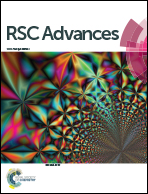Effect of low-temperature plasma treatment of electrospun polycaprolactone fibrous scaffolds on calcium carbonate mineralisation†
Abstract
This article reports on a study of the mineralisation behaviour of CaCO3 deposited on electrospun poly(ε-caprolactone) (PCL) scaffolds preliminarily treated with low-temperature plasma. This work was aimed at developing an approach that improves the wettability and permeability of PCL scaffolds in order to obtain a superior composite coated with highly porous CaCO3, which is a prerequisite for biomedical scaffolds used for drug delivery. Since PCL is a synthetic polymer that lacks functional groups, plasma processing of PCL scaffolds in O2, NH3, and Ar atmospheres enables introduction of highly reactive chemical groups, which influence the interaction between organic and inorganic phases and govern the nucleation, crystal growth, particle morphology, and phase composition of the CaCO3 coating. Our studies showed that the plasma treatment induced the formation of O- and N-containing polar functional groups on the scaffold surface, which caused an increase in the PCL surface hydrophilicity. Mineralisation of the PCL scaffolds was performed by inducing precipitation of CaCO3 particles on the surface of polymer fibres from a mixture of CaCl2- and Na2CO3-saturated solutions. The presence of highly porous vaterite and nonporous calcite crystal phases in the obtained coating was established. Our findings confirmed that preferential growth of the vaterite phase occurred in the O2-plasma-treated PCL scaffold and that the coating formed on this scaffold was smoother and more homogenous than those formed on the untreated PCL scaffold and the Ar- and NH3-plasma-treated PCL scaffolds. A more detailed three-dimensional assessment of the penetration depth of CaCO3 into the PCL scaffold was performed by high-resolution micro-computed tomography. The assessment revealed that O2-plasma treatment of the PCL scaffold caused CaCO3 to nucleate and precipitate much deeper inside the porous structure. From our findings, we conclude that O2-plasma treatment is preferable for PCL scaffold surface modification from the viewpoint of use of the PCL/CaCO3 composite as a drug delivery platform for tissue engineering.

- This article is part of the themed collection: Editors' collection: Physical Chemistry of Colloids and Interfaces


 Please wait while we load your content...
Please wait while we load your content...